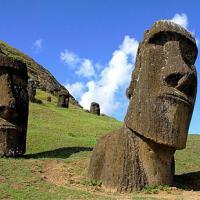Great Wonders: Easter Island's Moai 1800 - 1999 (full and started Feb 3)

Easter Island's Moai
The monolithic, stylized statues of Easter Island are considered a major feat of engineering, and the details of how they were carved, transported and raised between approximately 1250 and 1500 are still not fully known. Hundreds of moai were erected, ranging up to 33 feet high and weighing up to 86 tons, but nearly as many were left by their masons at the main moai quarry.
Great Wonders: Neuschwanstein Castle 1600 - 1799 (full and started Feb 3)

Neuschwanstein Castle
By the time Bavaria’s King Ludwig II built Neuschwanstein Castle in the late 19th century, castles weren’t necessary anymore for strategic defense — so it makes sense that he went all out in the aesthetics department. The result was a fanciful, many-turreted confection, romantic enough that it became the inspiration for the Sleeping Beauty Castle at Disneyland. Ludwig didn’t live to see it completed, but more than 60 million people have visited his finished creation.
Great Wonders: Samarkand 1400 - 1599 (full and started Feb 3)

Samarkand
Camels, caravans, silks and spices: Samarkand is a city of history, beauty and artwork, and is one of the oldest inhabited cities in the world. Founded by the Persians in approximately 700 B.C., it was conquered by Alexander the Great in 329 B.C., and later was controlled by the Mongols, Timurids and Turks. As one of the major cities on the Silk Road, Samarkand became a center for Islamic learning, and some of the most stunning examples of Muslim building and art can be found here. Today, Samarkand is the second-largest city in Uzbekistan.
Great Wonders: Kiyomizu Temple 1250 - 1399 (full and started Feb 3)

Kiyomizu Temple
Kyoto’s lovely wooden Kiyomizu temple, founded in the eighth century and rebuilt in 1633, features a main hall perched over a cliff, and a huge veranda held up by 139 49-foot-tall pillars — which is especially impressive given that no nails were used in the temple’s construction. The temple is also home to a number of gorgeous orange-and-white pagodas, considered among the loveliest in Japan. While you’re there, drink from the Otowa waterfall, said to have healing properties — Kiyomizu means “pure water.”
Great Wonders: The Alhambra < 1250 (full and started Feb 3)

The Alhambra
Harking back to the days when present-day Spain was a Muslim land, the Alhambra is a 700-year-old palace complex built by the Moors near Granada, in what is now the Andalusia region. Its name translates to "red fortress," reflecting the color of the clay used for much of its construction. The Alhambra's Islamic architecture and artwork are breathtaking, as are its outdoor features, including gardens and fountains.






